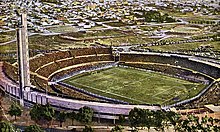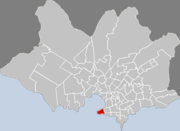
Montevideo is the capital and largest city of Uruguay. According to the 2011 census, the city proper has a population of 1,319,108 in an area of 201 square kilometers (78 sq mi). Montevideo is situated on the southern coast of the country, on the northeastern bank of the Río de la Plata.

The Viceroyalty of the Río de la Plata meaning "River of the Silver", also called "Viceroyalty of the River Plate" in some scholarly writings, in southern South America, was the last to be organized and also the shortest-lived of the Viceroyalties of the Spanish Empire in the Americas. The name "Provincias del Río de la Plata" was formally adopted in 1810 during the Cortes of Cádiz to designate the Viceroyalty of the Río de la Plata.
Banda Oriental, or more fully Banda Oriental del Uruguay, was the name of the South American territories east of the Uruguay River and north of Río de la Plata that comprise the modern nation of Uruguay; the modern state of Rio Grande do Sul, Brazil; and some of the modern state of Santa Catarina, Brazil. It was the easternmost territory of the Viceroyalty of the Río de la Plata.
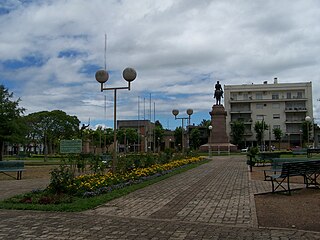
Salto is the capital city of the Salto Department in northwestern Uruguay. As of the 2011 census it had a population of 104,028 and is the third most populated city in Uruguay, after Montevideo and Ciudad de la Costa.

Ciudad Vieja is a historic neighbourhood in Montevideo, the capital of Uruguay. Located in a peninsula at the entrance of the natural port of Montevideo it was founded in 1724 as a walled city by the Spanish Empire, after the independence of Uruguay the city rapidly grew outwards and the Ciudad Vieja remained as one of the central neighbourhoods, nowadays it serves as one of the main office districts of Montevideo, housing multiple banks and institutions, but also as one of the main tourist attractions in Uruguay due to its historical significance and classical architecture.
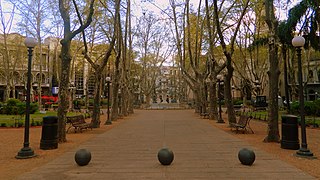
Plaza de la Constitución, also known as Plaza Matriz, is the oldest city square in Montevideo, Uruguay.

The Montevideo Cabildo is the public building in Montevideo that was used as the government house during the colonial times of the Viceroyalty of the River Plate. Today the building is used as a museum and houses the Historical Archive of the city. It is located on Constitution Square, in Ciudad Vieja.

The Legislative Palace of Uruguay is a monumental building, meeting place of the General Assembly of Uruguay, and the seat of the legislative branch of the Uruguayan government. It is located in the barrio of Aguada in the city of Montevideo.
There are many landmarks in Buenos Aires, Argentina some of which are of considerable historical or artistic interest.
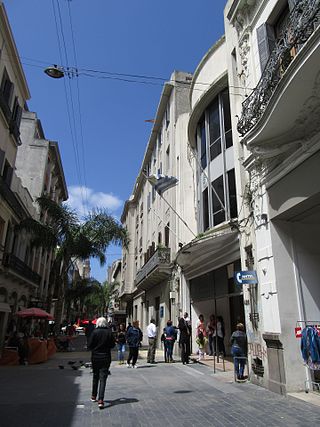
Peatonal Sarandí is an 0.5 miles pedestrian street in Ciudad Vieja, Montevideo, Uruguay. It is the main lane of the historic center, and one of the most touristic sites in the city, due to the fact that it is flanked by different architecturally notable buildings. The pedestrian street starts at the Gateway of the Citadel and ends at its intersection with Peatonal Pérez Castellano, while the remaining four blocks, up to the Rambla, are allowed for vehicles. As an extension of this street is the long southern breakwater of the Port of Montevideo, which has taken on the name "Escollera Sarandí".
The following is a timeline of the history of the city of Rio de Janeiro, Brazil.

The following is a timeline of the history of the city of Naples. The Naples area has been inhabited since the Neolithic period. The earliest historical sources in the area were left by the Myceneans in the 2nd millennium BC. During its long history, Naples has been captured, destroyed and attacked many times. The city has seen earthquakes, volcanic eruptions, foreign invasions and revolutions.
The following is a timeline of the history of the city of Madrid, Spain.
This is a timeline of the history of the city of Buenos Aires, Argentina.
The following is a timeline of the history of the city of Caracas, Venezuela.
The following is a timeline of the history of the city of Bogotá, Colombia.
The following is a timeline of the history of the city of Lima, Peru.
Juan Manuel Canaveris (1804-1868) was an Argentine jurist and politician, who served in Buenos Aires and Montevideo as attorney, teacher and military man. He participated of the escort of honor in the funerals of Manuel Dorrego, and collaborated in the early days of government of Juan Manuel de Rosas.
The following is a timeline of the history of the city of São Paulo, Brazil.


